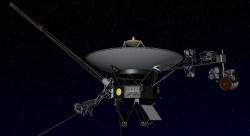We’ve all been ruined by science fiction, with their sound effects in space. But if you could watch a supernova detonate from a safe distance away, what would you hear?
Grab your pedantry tinfoil helmet and say the following in your best “Comic Book Guy” voice: “Don’t be ridiculous. Space does not have sound effects. You would not hear the Death Star exploding. That is wrong.” There are no sounds in space. You know that. Why did you even click on this?
Wait! I still have thing I want to teach you. Keep that tinfoil on and stick around. First, a quick review. Why are there sounds? What are these things we detect with our ear shell-flaps which adorn the sides of our hat-resting orb?
Sounds are pressure waves moving through a medium, like air, water or beer. Talking, explosions, and music push air molecules into other molecules. Through all that “stuff” pushing other “stuff” it eventually pushes the “stuff” that we call our eardrum, and that lets us hear a thing. So, much like how there’s not enough “stuff” in space to take a temperature reading. There’s not enough “stuff” in space to be considered a medium for sound to move through.
Don’t get me wrong there’s “stuff” there. There’s particles. Even in intergalactic depths there are a few hundred particles every cubic meter, and there’s much more in a galaxy. They’re so far apart though, the particles don’t immediately collide with each other allowing a sound wave to pass through a grouping of them.
So, even if you did watch the Death Star explode, you couldn’t hear it. This includes zapping lasers, and exploding rockets. Unless two astronauts touched helmets together, then they could talk. The sound pressure moves through the air molecules in one helmet, through the glass transferring from one helmet to the other, and then pushes against the air inside the helmet of the listening astronaut. Then they could talk, or possibly hear one another scream, or just make muffled noises under the face-hugger that had been hiding in their boot.
There’s no sound in space, so you can’t hear what a supernova sounds like. But if you’re willing to consider swapping out your listening meats for other more impressive cybernetic components, there are possibilities. Perhaps I could offer you something in a plasma detection instrument, and you could hear the Sun.

Voyager 1 detects waves of particles streaming from the Sun’s solar wind. It was able to hear when it left the heliosphere, the region where the Sun’s solar wind buffets against the interstellar medium.
Or you could try something in the Marconi Auralnator 2000 which is the latest in radio detector implants I just made up. If there was such a thing, you could hear the plasma waves in Earth’s radiation belts. Which would be pretty amazing, but perhaps somewhat impractical for other lifestyle purposes such as watching Ellen.
So, if you wanted to hear a supernova you’d need a different kind of ear. In fact, something that’s not really an ear at all. There are some exceptions out there. With dense clouds of gas and dust at the heart of a galaxy cluster, you could have a proper medium. NASA’s Chandra X-Ray Observatory has detected sound waves moving through these dust clouds. But you would need ears millions of billions of times more sensitive to hear them.
NASA and other space agencies work tirelessly to convert radio, plasma and other activity into a sound pressure format that we can actually hear. There are beautiful things happening space. I’ve included a few links below which will take you to a few of these, and they are really quite incredible.


I like the way you are filming, but when the camera is at a still position, it definitely needs a stand. My concentration gets deviated because I see the movement of the cameraman all the time against the tree’s. It might not have this effect when you would film in an open plain.
What would an actively accreting supermassive black hole sound like? Well, the SMBH at the center of NGC 1275 in the Perseus galaxy cluster emits a B-flat tone 57 octaves below middle-C:
http://science1.nasa.gov/science-news/science-at-nasa/2003/09sep_blackholesounds/
Studies of NGC 1275 (aka Perseus A) indicate it has probably been emitting this low frequency sound for more than 2 billion years!